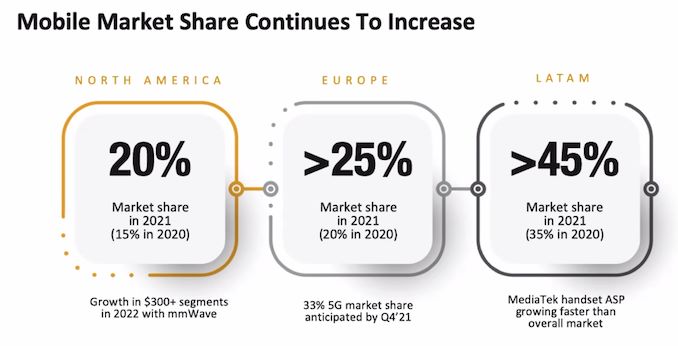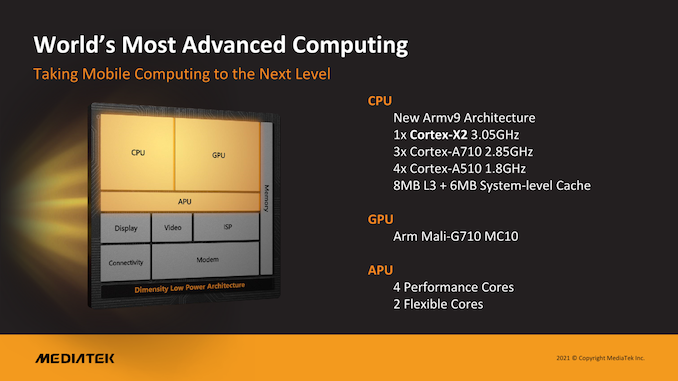MediaTek Announces Dimensity 9000: Supercharged Flagship SoC on 4nm
by Andrei Frumusanu on November 18, 2021 6:00 PM ESTConclusion & First Impressions
MediaTek’s re-entry in the flagship SoC space with the Dimensity 9000 comes at quite the opportunistic time in the landscape. The company has had a very successful 2021 with large market share gains, and we’ve even seen this translate into more exposure in more visible design wins in the market, such as the OnePlus Nord 2 series or the Xiaomi 11T.
Having seen large market share gains and being able to fill in a huge gap in the market where Huawei and HiSilicon were in the past, the Dimensity 9000 seems to have come at the perfect time, as more vendors want to be able to differentiate their highest end devices and diversify their reliance on Qualcomm’s Snapdragon series.
The Dimensity 9000, on paper, and by the specification, looks like an extremely strong SoC for 2022 flagships. On the CPU side of things, MediaTek has fully equipped the SoC with near the maximum possible configuration – high frequencies, large caches, and surprisingly enough for us today, a full performance configuration of the new Cortex-A510 cores. The 8MB L3 is helped by a new 6MB system cache that further improves memory performance, which the Dimensity 9000 of is currently the first and only chip to support new LPDDR5X.
The GPU side, the chip likely will be the only design for 2022 with a large Mali GPU. Advertised performance figures are good, but what matters most is power efficiency and sustained performance. While the metrics here are still a bit vague, the N4 process node of the chip, again, the first of its kind, is likely to position the chip in an excellently against 2021 devices, and if Qualcomm and Samsung don’t have major leaps in their upcoming designs, also position the Dimensity 9000 extremely well against the 2022 competition.
MediaTek’s camera and ISP leaps are also just huge. We haven’t really had many camera-centric phones powered by MediaTek silicon over the last few years, so if vendors are able to take advantage of the chip’s new camera architecture remains to be seen, but at least the high-level specifications are definitely worthy of 2022 flagships.
The chip’s lack of mmWave is likely limit its success to non-US markets and devices, but that’s a situation we generally become used to over the years.
The Dimensity 9000 is MediaTek’s strongest showing in years, and has the specifications and heft to properly shake up the high-end market. I see it competing against, or even besting whatever Qualcomm has in queue for next year, which is a pretty shocking turn of events. What matters now, is for MediaTek to actually have the high-profile flagship device design wins, to be able to fully rationalise their investment in such a SoC. Luckily, we’ve been told the chip has already sampled to customers, and we’re to expect commercial device launches in the first quarter of 2022. Exciting times are ahead in the mobile SoC space.












150 Comments
View All Comments
Fulljack - Friday, November 19, 2021 - link
very interested with this SoC. thankfully my country are pretty competitive regarding smartphone market, so I'll expect any device with Dimensity 9000 SoC will be sold at around ~500US$ ballpark, which is cheap compared to what similarly specced Qualcomm device.I know that Mediatek has such terrible support and openness toward modding communities, but I'm hopeful with how Google has designed Android 12 as very modular, also how Linux kernel 5.10 has support GKI, I'm very positive it'll have good—if not mediocre aftermarket support from the modding communities.
KarlKastor - Friday, November 19, 2021 - link
The L2 Cache of the A510 is shared, so it should be 2x 256KB in the table.Wereweeb - Friday, November 19, 2021 - link
Read the article. Mediatek didn't merge the A510's into complexes, so L2 isn't shared.KarlKastor - Friday, November 19, 2021 - link
My bad. I somehow managed to skip this part.dharmOS - Friday, November 19, 2021 - link
I would love to see a SoC like this in a ChromeBook. I have an Asus Flip C101 using an OP1/Rockchip 3399 (2xA72, 4x A53), which is fantastic for the last 6 years but getting a bit old and runs out of updates from Aug 23. Very few ChromeBooks with decent ARM options.As an aside, really important that Mali graphics continues to survive under ARM/Softbank, as the potential future Nvidia buyout would wipe this out and replace it with one of their more expensive GPU options.
nandnandnand - Friday, November 19, 2021 - link
I'm sure you would. In reality you will see MT8195 and MT8192 with 4x Cortex-A78 or A76 and 4x A55. Either one should be a great upgrade.mode_13h - Saturday, November 20, 2021 - link
> really important that Mali graphics continues to survive under ARM/Softbank,> as the potential future Nvidia buyout would wipe this out
That would be interesting if regulators made them sell or spinoff the GPU division. Sadly, if we look at Imagination's poor fortunes, the prospects for a spinoff wouldn't look great.
Tigran - Friday, November 19, 2021 - link
>>in terms of per-core performance one new G710 core is roughly equivalent to two G78 cores<< Is it really true? When Mali-G710 was presented by ARM, they promised +20% gaming performance VS vs Mali-G78.CrisJim1997 - Friday, November 19, 2021 - link
Yeah & I think the GPU of this Dimensity 9000 packs more than 2TFLOPS of FP32 FLOPSss91 - Sunday, November 21, 2021 - link
I think it was meant for comparison with G78 chips made on same process node. Samsung 5nm is already said to be worse than TSMC 5nm, I’d imagine 4nm makes the gap bigger.While I have my reservations with the amount of benefit that can come from node (pretty sure it’s not going to be 67% better than Samsung node), it’s to be assumed that marketing claims will be a little more than the actual